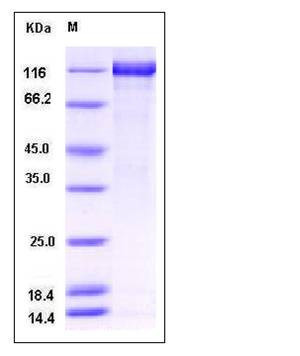Human Contactin 4 / CNTN4 Protein (His Tag)
AXCAM,BIG-2
- 100ug (NPP3748) Please inquiry
| Catalog Number | P10178-H08B |
|---|---|
| Organism Species | Human |
| Host | Baculovirus-Insect Cells |
| Synonyms | AXCAM,BIG-2 |
| Molecular Weight | The secreted recombinant human CNTN4 consists of 993 amino acids and has a calculated molecular mass of 110 kDa. It migrates as an approximately 120-130 kDa band as predicted in SDS-PAGE under reducing conditions. |
| predicted N | Asp 19 |
| SDS-PAGE |  |
| Purity | > 90 % as determined by SDS-PAGE |
| Protein Construction | A DNA sequence encoding the mature form of human CNTN4 isoform 1 (Q8IWV2-1) (Met 1-Ser 1000) was fused with a polyhistidine tag at the C-terminus. |
| Bio-activity | |
| Research Area | Developmental Biology |Organogenesis |Nervous system development |
| Formulation | Lyophilized from sterile 20mM Tris, 500mM NaCl, pH 8.5, 10% gly 1. Normally 5 % - 8 % trehalose and mannitol are added as protectants before lyophilization. Specific concentrations are included in the hardcopy of COA. |
| Background | Contactin-4, abbreviated as CNTN4, is a brain-derived protein belonging to the immunoglobulin superfamily. It has been found high expression in testes, thyroid, small intestine, uterus and brain. This protein is an neuronal membrane protein that functions as an glycosylphosphatidylinositol- anchored cell adhesion molecule. Contactin-4 is considered as a candidate protein responsible for the differentiation potential of human neuroblastoma cells and it has been implicated in some cases of autism and spinocerebellar ataxia type 16. Studies of the cantactin family have revealed a complex pattern of hemophilic and heterophilic interactions that are required for axon growth and pathfinding. Such studies demonstrate that these essential functions are mediated by the combination and juxtaposition of multiple Ig and FNIII domains. Second, these neuronal adhesion molecules demonstrate highly regulated temporal and spatial expression patterns in the CNS. For this reason, the disruption of the regulatory region of the predominant brain-expressed isoform reasonable would be expected to have significant functional consequences. |
| Reference |
